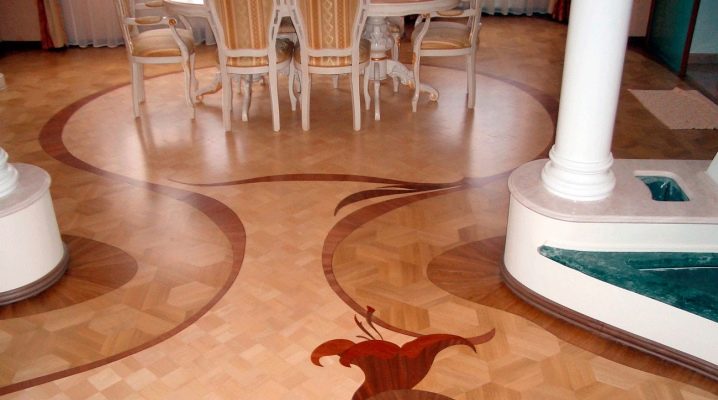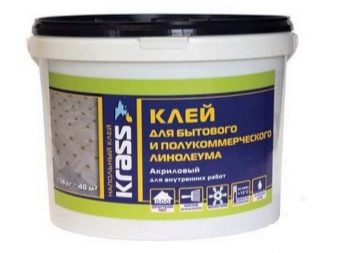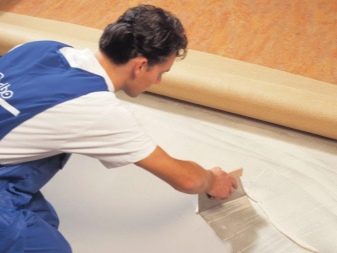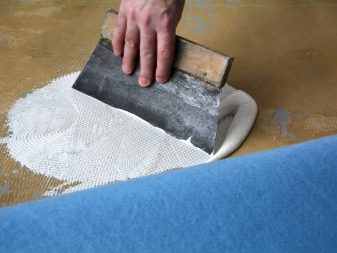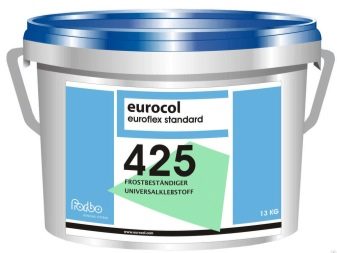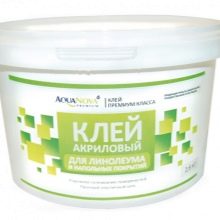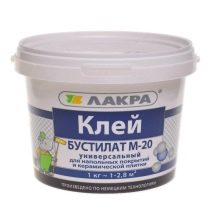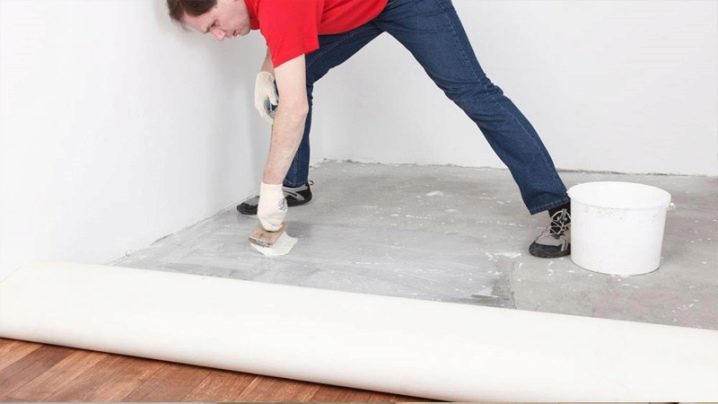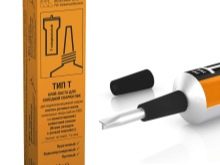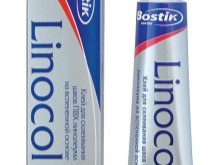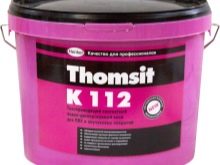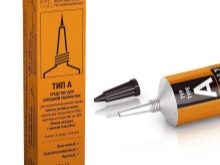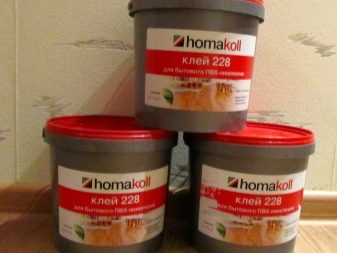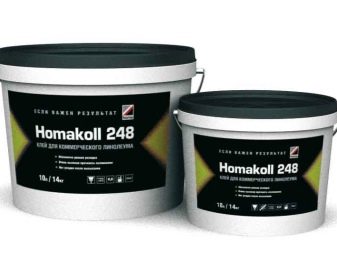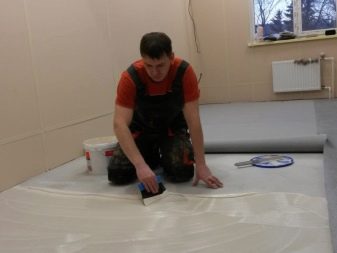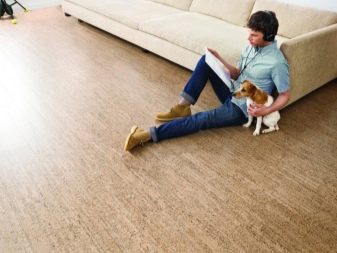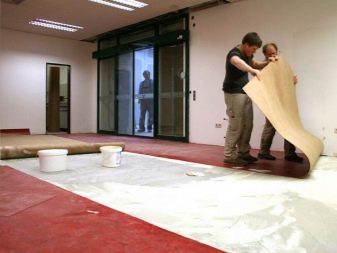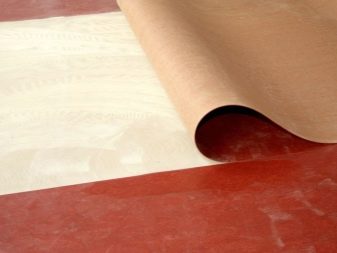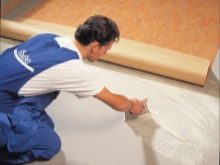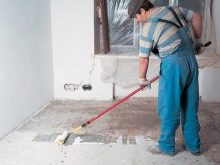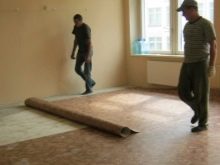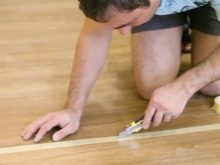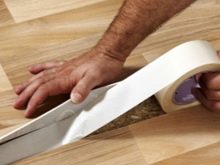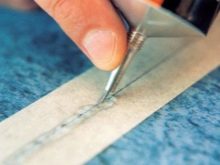Choosing glue for linoleum
Linoleum is one of the varieties of roll materials that are used as a floor covering. The peculiarity of this product is its relatively small size and structure of its canvas. It does not allow the sheet to fit tightly and evenly on the surface. This problem can be solved with the help of special adhesive solutions. The modern market produces many varieties of these products, so you need to choose glue for linoleum only in accordance with the technical parameters and the purpose of the latter.
Advantages and disadvantages
Glue for linoleum is designed to solve various problems. With it, you can not only glue the fabric to the floor, but also make a strong seam without visible joints.
Such products have several significant advantages:
- Linoleum sticks to the floor more firmlywhile forming a flat surface. This eliminates distortions. In this case, the material is not damaged during operation, which makes it possible to extend its service life to 15 years.
- Minimum expense. The mixture is consumed in relatively small volumes, which makes it possible to quickly and efficiently cover a large area with it.
- Simple application technology. The process of gluing involves covering the floor with glue using a brush or a special spatula (depending on the type of mortar).
- Environmental friendliness. This applies to water-dispersion formulations that contain practically no harmful substances. Therefore, they can be used both at home and at industrial enterprises.
- Water resistance and plasticity. This applies only to the reaction adhesive, which forms a strong homogeneous bond with the web.
But glue for linoleum is not always a unique solution, as it hasa few weighty cons:
- The substance does not hide the surface roughness, which requires its additional alignment, if necessary.
- The solution is not recommended for use with substrates that can act as additional insulation.
- Low water resistance. If linoleum will be operated in a wet environment, the glue will lose its properties over time, and the material will lag behind the surface (this does not apply to reaction modifications).
- Low frost resistance. This also applies to water-dispersion solutions that are not intended for use in such conditions.
- Toxicity. Similar characteristics have reactionary types of glue, which do not always recommend the use in domestic premises.
Kinds
Manufacturers of glue for linoleum produce several modifications of them, which differ in the composition and environment of use.
Depending on these characteristics, these compositions can be divided into 2 large groups:
- Water dispersion. The composition of such a substance can include both PVA glue and water-based acrylic. It all depends on the manufacturer and purpose of the specific brand of glue. Apply similar compositions for fixing the canvas to the floor covering.
- Reactionary. A feature of this substance is that it enters into a chemical reaction with linoleum. During this interaction, the material melts, forming a liquid. After hardening, this mixture turns into linoleum again. Use reactive adhesives for joining or repairing. Most formulations are designed to work with PVC coatings.
Dispersion glue, in turn, is divided into the following groups:
- Bustilat. This is the most common glue that has been used for a very long time. This substance consists of CMC, latex, chalk and auxiliary components. The solution is perfect for linoleum, which have a felt base.
- Polymer formulations. The basis of such substances include resins that allow you to bind vinyl linoleum of almost any kind. A striking example of this solution is Homakoll 208.
- Acrylate. Such a solution consists of an acrylic blend that is intended for heterogeneous and homogeneous linoleum. This glue can be applied even on surfaces that are poorly absorbed by liquids.
- Gumilax. Glue of this brand is made from a mixture of rubber and natural latex.It is used for fixing linoleum from natural materials.
- Conductive. This is a special glue, which is used when installing antistatic linoleum. Such coatings are not able to accumulate electric current, which makes them very popular when a heated floor or other similar systems are formed.
For fixing linoleum, special glue-pastes or liquid nails are sometimes used. But they are only suitable for certain types of surfaces and materials, so they are not so common.
Reaction glue is also very often used to work with linoleum.
Today there are several types of glue for cold welding:
- Type A. This adhesive is used to connect minimum joints of no more than 2 mm. This is due to the fact that the substance has a liquid consistency and is not capable of seizing materials at a great distance. Cold welding of this type allows you to get not only waterproof and frost-resistant, but almost not noticeable weld. Experts recommend using glue for new sheets of linoleum, as they have smooth ends and can be joined with a minimum gap.
- Type C. In the composition of the solution is already much more PVC filler and the minimum amount of solvent. Therefore, the mixture is already much thicker, which makes it possible to fill up cracks up to 4 mm in size. This type of glue is excellent for repairing linoleum (cuts, etc.).
- Type T. A mixture of this type is used to connect linoleum on the basis of several components. The composition can react with products from polyester and PVC. This glue is suitable even for semi-commercial coatings.
Manufacturers
The modern market of linoleum glue is saturated with various compositions, which differ in chemical composition and environment of use. Among the manufacturers of the reaction compositions can be distinguished several well-known brands:
- Werner Muller. The products of this company are of high quality. The main focus is the release of glue for the joints. The use of this substance allows you to get a strong connection at a flow rate of up to 10 meters.
- Linocol. Particular attention should be paid to adhesives, which are intended for heterogeneous types of linoleum. This product is distinguished by quality and optimum consumption.
- Thomsit K. The company produces several types of glue that can be used both for joining seams and repairing cuts.
The market for water dispersion materials also has its leaders:
- Homakoll. The company produces a large number of mixtures for binding linoleum. Here are found both universal formulations and those that can only be used for a certain type of substance. Among all this diversity, there are also conductive mixtures and solutions for heterogeneous sheets with a felt or jute base.
- Forbo Erfurt. Under this brand produced one of the highest quality water-dispersion adhesives. The company's products has many varieties that can be used for almost all types of linoleum. It should be noted that the manufacturer also produces mixtures that dry much faster than their counterparts.
How to calculate the quantity?
The consumption of each type of glue for linoleum depends on several main factors:
- type of base (concrete, wood);
- purpose (welding or fixing to the floor).
The calculation of the required amount of the mixture is quite simple and involves the following sequence of actions:
- First you need to know the flow of glue. This value is often indicated on the product packaging. In most cases, it is indicated by a range. It is best to use the lower limit for calculations, as this will provide you with a certain margin.
- To calculate the right amount of the mixture, the flow should be multiplied by the area to be covered with them. For example, at a rate of 0.5 kg per square meter for a room of 10 square meters. You will need 5 kg of solution. If you buy a reaction adhesive for welding joints, then its consumption is indicated in grams or milliliters per linear meter. This value must be multiplied by the length of the seam.
How long does it dry?
The drying time of the glue is not universal, as it depends on the temperature conditions inside the room, the type of composition and the volume that was applied. Often, dispersion solutions dry in 1-2 days.
At the same time it is important not to influence linoleum in any way, as this may lead to its shift. Cold welding, in turn, will completely harden in a few hours, which makes it possible to quickly cope with the seam joining.
Which to choose?
The variety of adhesive compositions is so great that it is not always possible to correctly navigate the choice. To obtain a quality result, you should consider the following factors:
- Application area. If you plan to lay linoleum on the floor, then you need to look towards the water-dispersion formulations. It should be noted that they are completely harmless and can be used in domestic premises. When you need to perform gluing seams, then the best option would be cold welding.
- Surface type Adhesive compounds are intended for certain types of floors. Some of them can withstand moisture, while others need a minimum amount of it to spoil. You can find out all these characteristics on the packaging of each glue.
- Type of linoleum. This feature is one of the most important. Almost all types of glue work with materials based on PVC, but sometimes there are products for natural substances. Cold welding can often be used for homogeneous foam sheets, as this will provide a reliable and elastic seam. For commercial and semi-commercial linoleum, suitable types of bustilat or polymer compounds.
Algorithm of work
Gluing linoleum to the floor is performed in several steps:
- Initially, the floor is leveled, thoroughly cleaned and dried.If the surface absorbs moisture very strongly, then it is desirable to first prime it.
- After this glue is applied to the floor with a notched trowel. When it is distributed, you need to give it a little dry. Specific time can be found on the packaging of products.
- The procedure ends with the laying of linoleum. In order for the sheet to stick properly, it should be rolled on with a roller to remove air.
If you need to seal the cracks or join the seams, then this procedure involves the following operations:
- Initially, all the joints are aligned, especially if you are mounting a new material.
- After that, they are glued double sided masking tape. It is needed to prevent glue from entering the linoleum. When it is glued, you need to make a slot along the entire length of the seam.
- The process is completed by filling the seam with glue. To do this, a special nozzle in the form of a needle is put on the tube. With it, the mixture is fed into the seam. Its quantity should be such that it protrudes slightly above the surface of the linoleum. Similarly, the gap is filled along the entire length. When everything is ready, you need to leave the substance for 20 minutes, after which you can remove the adhesive tape.The seam itself will harden after a few hours.
Working with glue for linoleum is not difficult and requires only the choice of quality material and compliance with the manufacturer's instructions.
The following video is about how to choose the right glue and calculate the flow.
